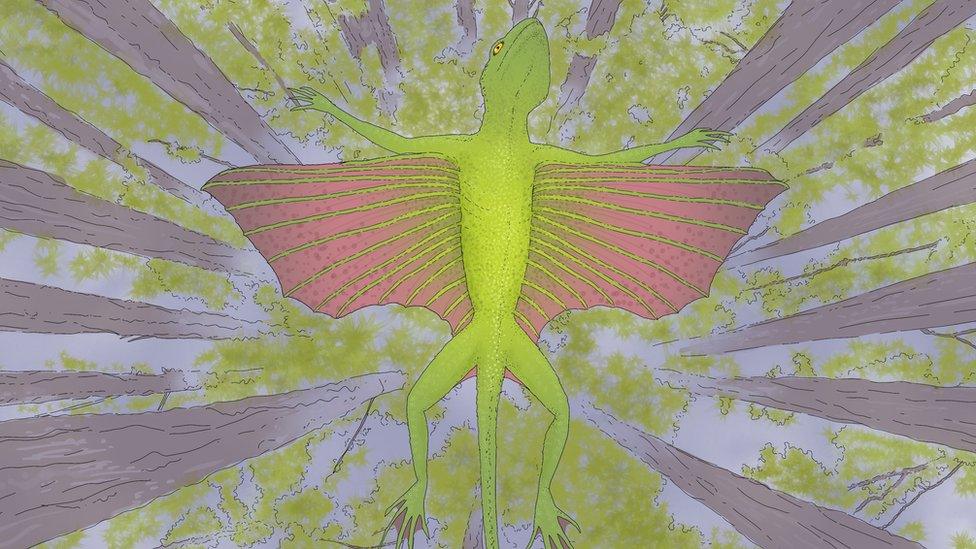Flying reptiles 'lived in pre-historic' Somerset hills
- Published

Artist’s impression of a gliding reptile Kuehneosaurus which research said lived in Somerset
Flying, winged reptiles lived in Somerset 200 million years ago, new research has found.
Kuehneosaurs resembled lizards, and were closely related to the ancestors of crocodilians and dinosaurs the University of Bristol study said.
The small animals could neatly fit in the palm of a hand.
Student Mike Cawthorne said he had initially hoped to discover "some dinosaur bones but ended up finding "everything else but dinosaurs".
There were two species of kuehneosaurs, with one boasting extensive wings while the other had shorter wings. These were made from a layer of skin which stretched over their elongated side ribs, allowing them to glide from tree to tree.
'Launch themselves'
Similar to the modern flying lizard Draco, which hails from southeast Asia, the kuehneosaurus wandered about on the ground, climbing trees as they preyed on insects.
With the help of their wings, the creatures could launch themselves up into the air after being startled or spotting an insect, and land safely 39ft (10m) away.

The partial skeleton of gliding reptile Kuehneosaurus was found on rock from Emborough, Somerset
Mr Cawthorne, a masters student, made the discovery. Mr Cawthorne researched numerous reptile fossils from limestone quarries, forming the biggest subtropical island at the time, called the Mendip Palaeo-island.
The study, which was published in Proceedings of the Geologists' Association, also records the presence of reptiles with complex teeth, the trilophosaur Variodens and the aquatic Pachystropheus.
The latter is thought to have lived a bit like a modern-day otter, likely eating shrimps and small fish.
The animals either fell or their bones were washed into caves and cracks in the limestone.
"The collections I studied had been made in the 1940s and 1950s when the quarries were still active, and palaeontologists were able to visit and see fresh rock faces and speak to the quarrymen," Mr Cawthorne said.
'A lot of work'
Professor Mike Benton from Bristol's School of Earth Sciences said that it took "a lot of work" to identify the fossil bones, most of which were not part of a skeleton.
Mr Benton said: "However, we have a lot of comparative material, and Mike Cawthorne was able to compare the isolated jaws and other bones with more complete specimens from the other sites around Bristol.
"He has shown that the Mendip Palaeo-island, which extended from Frome in the east to Weston-super-Mare in the west, nearly 18.6 miles (30km) long, was home to diverse small reptiles feeding on the plants and insects."
Mr Benton explained that, whilst Mr Cawthorne did not find any dinosaur bones, "it's likely they were there" as dinosaur bones have been found in other locations of the same geological age around Bristol.

Follow BBC West on Facebook, external, X, external and Instagram, external. Send your story ideas to: bristol@bbc.co.uk , external